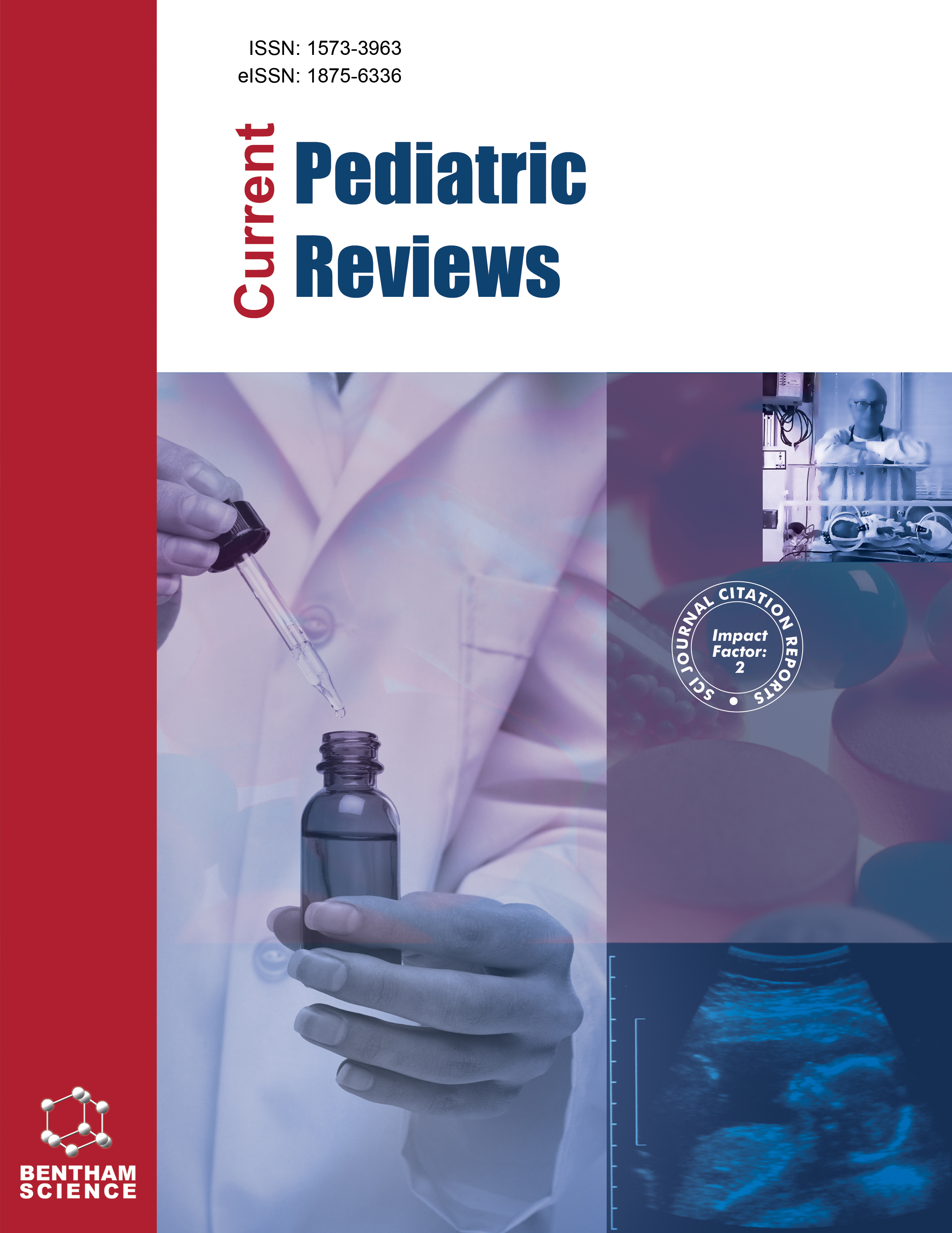- Home
- A-Z Publications
- Current Pediatric Reviews
- Previous Issues
- Volume 10, Issue 2, 2014
Current Pediatric Reviews - Volume 10, Issue 2, 2014
Volume 10, Issue 2, 2014
-
-
Renal and Urological Diseases of the Newborn Neonatal Acute Kidney Injury
More LessSurvival of critically ill neonates in the intensive care unit has improved over the past decades reflecting improvements in obstetric, delivery room and neonatal intensive care, however, morbidity remains significant. Acute kidney injury is a common occurrence in these neonates and despite improved understanding of the pathophysiology and management of acute kidney injury in full term and preterm infants, the mortality r Read More
-
-
-
Inherited Renal Diseases
More LessGenetic disorders of the kidney include cystic diseases, metabolic diseases and immune glomerulonephritis. Cystic diseases include autosomal dominant and recessive polycystic kidney disease (ADPKD, ARPKD, respectively). Neonates with enlarged, cystic kidneys should be evaluated for PKD. Patients with ADPKD have cysts and renal enlargement. Most patients present with hypertension, hematuria or flank pain; the most Read More
-
-
-
Renal Venous Thrombosis in Neonates
More LessBy Asha MoudgilNeonatal renal vein thrombosis (RVT) is associated with potentially serious morbidities. Almost 80% of cases of RVT present within the first postnatal month. The most common risk factors for RVT are birth asphyxia/ in utero fetal distress, being the infant of a diabetic mother, volume contraction and coagulation abnormalities. Thrombus formation may be initiated by vascular injury, diminished vascular flow, increased blood viscos Read More
-
-
-
Renal Development: A Complex Process Dependent on Inductive Interaction
More LessAuthors: Kiran K. Upadhyay and Douglas M. SilversteinRenal development begins in-utero and continues throughout childhood. Almost one-third of all developmental anomalies include structural or functional abnormalities of the urinary tract. There are three main phases of in-utero renal development: Pronephros, Mesonephros and Metanephros. Within three weeks of gestation, paired pronephri appear. A series of tubules called nephrotomes fuse with the pronephri Read More
-
-
-
Fluid and Electrolyte Disorders in the Newborn: Sodium and Potassium
More LessAuthors: Marta Suarez-Rivera and Melvin Bonilla-FelixTubular development continues after birth in full and pre-term infants. As the survival of premature infants increases, serious imbalances in water and electrolytes in this group have become more prevalent. A diminished ability of the immature kidney to reabsorb water and respond to mineralocorticoids, a high excretion of filtered sodium, perinatal complications affecting tubular function, and the use of medications su Read More
-
-
-
Congenital Anomalies of the Urinary Tract
More LessAuthors: Hans G. Pohl and A. Barry BelmanThe upper urinary tract forms as a consequence of the reciprocal inductive signals between the metanephric mesenchyme and ureteric bud. A clue to the timing of events leading to an abnormality of the upper urinary tract can be the presence also of associated anomalies of internal genitalia since separation of these systems occurs at about the 10th week of gestation. Prenatal sonography has facilitated the detection of urolo Read More
-
-
-
Disorders of Mineral Metabolism in the Newborn
More LessDisorders of calcium and phosphorus homeostasis present both acute and chronic clinical consequences for newborns. The etiologies responsible range from iatrogenic, idiopathic, and inherited metabolic abnormalities. Maintenance of physiologically normal serum calcium and phosphorus requires complex interactions between the kidneys, gastrointestinal tract, and bone. Calciotropic hormones such as vitamin D and parat Read More
-
-
-
Assessment of Glomerular and Tubular Function
More LessAuthors: Kanwal Kher and Kirtida MistryAt birth, GFR and tubular function of neonates is compromised as compared to older children and adults. These functions are even less developed in premature infants. These facts have a direct bearing on drug dosing, fluid and electrolyte administration, and maintenance of acid-base balance in neonates. Although many detailed methods of assessing renal functions have been provided in this article, laboratory and radiologic s Read More
-
-
-
Nonalcoholic Fatty Liver Disease In Children: Recent Practice Guidelines, Where Do They Take Us?
More LessAuthors: Ashish Aggarwal, Kanika Puri, Suraj Thangada, Nizar Zein and Naim AlkhouriNonalcoholic fatty liver disease (NAFLD) is the most common cause of chronic liver disease in children and adolescents in the United States. It is strongly associated with childhood obesity, insulin resistance and metabolic syndrome. Although some children with NAFLD may remain asymptomatic, progression to nonalcoholic steatohepatitis (NASH), and to advanced stages of fibrosis and cirrhosis is well recognized. U Read More
-
-
-
Surfactant-Associated Proteins: Structure, Function and Clinical Implications
More LessAuthors: Anastasia K. Ketko and Steven M. DonnSurfactant replacement therapy is now the standard of care for infants with respiratory distress syndrome. As the understanding of surfactant structure and function has evolved, surfactant-associated proteins are now understood to be essential components of pulmonary surfactant. Their structural and functional diversity detail the complexity of their contributions to normal pulmonary physiology, and deficiency states res Read More
-
Volumes & issues
-
Volume 21 (2025)
-
Volume 20 (2024)
-
Volume 19 (2023)
-
Volume 18 (2022)
-
Volume 17 (2021)
-
Volume 16 (2020)
-
Volume 15 (2019)
-
Volume 14 (2018)
-
Volume 13 (2017)
-
Volume 12 (2016)
-
Volume 11 (2015)
-
Volume 10 (2014)
-
Volume 9 (2013)
-
Volume 8 (2012)
-
Volume 7 (2011)
-
Volume 6 (2010)
-
Volume 5 (2009)
-
Volume 4 (2008)
-
Volume 3 (2007)
-
Volume 2 (2006)
-
Volume 1 (2005)
Most Read This Month
Article
content/journals/cpr
Journal
10
5
false
en


